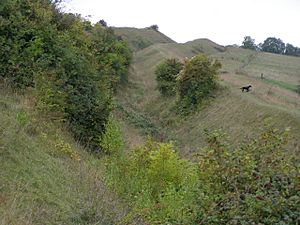Hod Hill facts for kids
Quick facts for kids Hod Hill |
|
|---|---|
| Highest point | |
| Elevation | 143 m (469 ft) |
| Prominence | c. 68 m |
| Geography | |
| Location | Blackmore Vale, Dorset, England |
| OS grid | ST856106 |
| Topo map | OS Landranger 194 |
Hod Hill is a big, ancient hill fort located in Dorset, England. It's about 3 miles (5 km) north-west of Blandford Forum. This fort sits on a chalk hill, also called Hod Hill, which is 143 meters (469 feet) high.
The name "Hod Hill" might come from an old English word. It could mean "shelter" or "hood," perhaps because of the hill's shape. Another famous hill fort, Hambledon Hill, is just north of Hod Hill.
Contents
What is Hod Hill?
Hod Hill is shaped like a rectangle. It measures about 600 meters (1,969 feet) long and 400 meters (1,312 feet) wide. The total area inside the fort is about 22 hectares (54 acres).
On its western side, the hill has a very steep natural slope. This slope goes down to the River Stour. The other sides of the fort have man-made defenses. These include a strong rampart (a large bank of earth), a deep ditch, and an outer bank called a counterscarp. The north side has an extra rampart for more protection.
The main entrance to the fort is at its south-east corner. There are also other openings at the south-west and north-east corners.
Life in the Iron Age
People lived in the Hod Hill fort during the late Iron Age. These people were part of a tribe called the Durotriges. We don't know if they were the same group who first built the fort's main rampart around 500 BC.
Archaeologists have found many signs of settlement inside the fort. These include flat areas where roundhouses (circular homes) once stood.
The Romans Arrive
In AD 43, the Roman army captured Hod Hill. The Romans were led by a general named Vespasian. His army, the Second Legion (Augusta), had already taken other hill forts like Maiden Castle.
Archaeologists found eleven iron ballista bolts on the hill. These are like large arrows shot from a Roman war machine. They were found near an area called the "Chieftain's hut." This area had two hut circles, one with a fence around it.
There were no other signs of a big battle. This suggests that the Durotriges tribe likely surrendered to the powerful Roman army.
A Roman Camp
After capturing the fort, the Romans built their own camp inside it. This Roman camp was about 200 square meters (2,153 square feet) in size. It was in the north-west corner of the original hill fort.
About 720 Roman soldiers lived in this camp. They were a mix of legionaries (main Roman soldiers) and auxiliaries (soldiers from other parts of the Roman Empire). The Romans used Hod Hill as a base for about five or six years.
Around AD 50, the camp was no longer used. Many troops were sent to fight in Wales. The remaining soldiers moved to a new fort further west at Waddon Hill.
Discovering the Past
Sir Ian Richmond led excavations at Hod Hill in the 1950s. An excavation is when archaeologists carefully dig up a site to find old objects and structures. His full report about the findings was published in 1969.
Today, Hod Hill is an important place for nature. It is a calcareous grassland habitat, which means it has special soil. Many beautiful wild flowers and butterflies live there.
Images for kids
See also
 In Spanish: Hod Hill para niños
In Spanish: Hod Hill para niños



